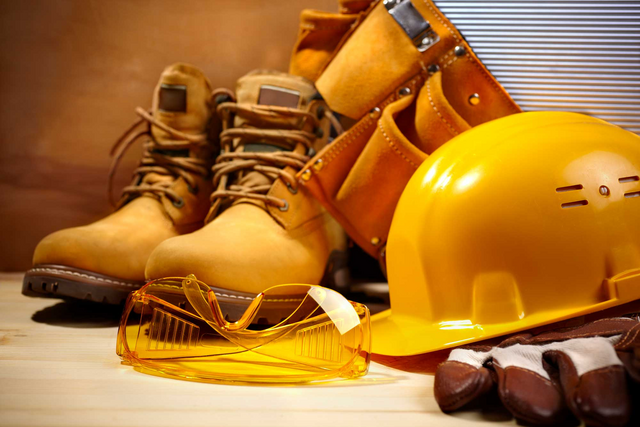Key Takeaways
Industrial safety protocols:- Safety Protocols: Essential for worker protection and accident reduction.
- Contractor Role: Crucial in equipment selection, compliance, and training.
- Technology: Offers advancements for enhanced safety measures.
Industrial construction sites are a hub of activity, with workers and heavy machinery constantly in motion. That is why it’s essential to understand the significance of industrial safety protocols and their implementation for industrial construction contractors.
This blog will explore everything about industrial safety protocols- what they are, why they matter, and how they can be effectively employed. We will discuss the critical elements of safety protocols, including personal protective equipment (PPE), worker training programs, and regular inspections. Additionally, we will explore the role of construction contractors in ensuring industrial safety and provide case studies of successful safety implementations. We will also highlight the legal and financial consequences of ignoring safety protocols in industrial construction. Join us as we navigate through the world of industrial safety protocols in this informative blog post.
Industrial Construction Contractors: Understanding Industrial Safety Protocols
Industrial safety protocols safeguard workers, reduce accidents, and promote a safe work environment. They include guidelines for handling hazardous materials and heavy loads and require regular employee training.
Implementing safety protocols in industrial construction is something that is provided by OSHA so that workers are kept safe when working. Whether you are a project manager or construction worker, these protocols are designed to help you.
Key Elements of Industrial Safety Protocols
Industrial safety protocols are broken down into a few different categories that industrial construction contractors can follow. This makes it easier to understand what is necessary to keep everyone safe and efficient on construction sites.
Safety Equipment and Gear
Safety gear, including helmets, gloves, and safety glasses, is essential for worker protection and should be provided based on specific job hazards. Workers should be trained on how to use safety equipment and gear, how to clean it, and when maintenance is necessary.
Safety Training for Workers
Comprehensive training ensures workers understand hazards, emergency procedures, and proper safety equipment usage. In comparison, ongoing tailored training reinforces safe practices while maintaining records for compliance. Project managers may need to provide different kinds of training depending on the materials and jobs workers will be in charge of. This ensures everybody knows what to do and how to do it in the safest way possible.
Regular Safety Audits and Inspections
Regular safety audits assess safety protocols for potential improvements and ensure consistent compliance with regulations by conducting inspections. Audits identify hazards and recommend preventive measures, with reports shared among stakeholders. It is also important to encourage feedback from workers to locate any unnoticed safety risks that could be improved upon.
Role of Construction Contractors in Implementing Safety Protocols
Whether you are an industrial construction contractor or project manager, you are in charge of specific protocols. A typical example is safety protocols, which help keep your team safe on the site. Here are some examples of the tasks you must accomplish to reduce liability and injury risk.
Selection of Proper Equipment and Tools
Construction contractors should prioritize choosing equipment and tools that meet safety standards and receive regular maintenance. Providing workers with appropriate tools and conducting inspections helps enhance overall safety on construction sites and makes them more efficient.
Ensuring Compliance with Safety Regulations
Staying updated with safety regulations, enforcing protocols, and engaging safety consultants are vital for compliance and preventing legal issues. You should regularly review local safety regulations since certain details can change yearly.
Arranging Safety Training Programs
Construction contractors should organize comprehensive safety training programs covering all relevant safety protocol aspects. This includes providing regular refresher courses, collaboration with safety experts, and worker participation.
Consequences of Ignoring Safety Protocols in Industrial Construction
There are a lot of legal protocols involved when it comes to industrial construction sites. Because of this, you do not want to ignore safety protocols since they can have serious repercussions. Here are some examples of what can happen if safety protocols are ignored or not followed through appropriately.
Legal Implications
Understanding the legal consequences of non-compliance with safety protocols is important, including potential penalties and fines. Things like regulatory agencies’ enforcement actions, reputational damage, and legal battles can all result from non-compliance.
Financial and Operational Consequences
Accidents and injuries in industrial construction projects have significant financial implications, including increased costs and project schedule disruptions. Neglecting safety protocols can lead to long-term operational consequences, severe financial setbacks for companies, and potential lawsuits.
How to Improve Current Safety Protocols?
If you want to enhance safety protocols in industrial construction, you will need to look into integrating technological advances. Technological advances have the potential to revolutionize safety protocols in industrial construction by enhancing worker safety through wearable devices, IoT, and automation. Real-time monitoring systems can detect hazards, while drones and robotics facilitate safer inspections and maintenance. The future of safety technology holds exciting possibilities for the industry.
It is also important to create a culture of safety that promotes safety awareness, involves leadership, and prioritizes safety as a core value for enhanced productivity and employee engagement. Everybody needs to be involved and take personal responsibility to truly have a safe construction site.
Conclusion
Industrial safety protocols are crucial for ensuring the well-being of workers and the success of construction projects. Industrial construction contractors can achieve this by implementing proper safety measures, such as providing necessary equipment and gear, conducting regular audits, and arranging comprehensive training programs. Ignoring safety protocols can have serious consequences, including legal implications, worker injuries, and financial losses.
To improve current safety protocols, embracing technological advancements and promoting a culture of safety within the industry is essential. Workers need the proper safety gear and training depending on their job and the materials they handle. Industrial construction contractors can create a safer and more productive work environment for everyone involved by prioritizing safety.

